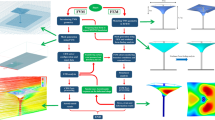Abstract
The structural model of the workpiece is required for modeling, analysis, and avoidance of forced and regenerative (chatter) vibrations in machining of thin-walled parts. Finite element models (FEM) provide a versatile means for modeling the workpiece dynamics, but such models need to be updated frequently as the mass and stiffness of the workpiece varies continuously during machining. The computational time and power that is needed for re-meshing the FEM and then re-computing the natural modes of the workpiece is prohibitive. In this paper, a new approach based on Finite strip modeling (FSM) is presented for modeling the structural dynamics of thin-walled structures during pocket milling operations. The substantially higher computational efficiency of the FSM approach in predicting the varying dynamics of thin-walled pocket structures is verified by comparing its performance against FEM and the multi span plate (MSP) approach presented in (J Manuf Sci Eng 133:021014, 2011). Additionally, the accuracy of the presented approach in analyzing the stability of vibrations and determining the extent of dynamic deflections is verified using experimental results.
Similar content being viewed by others
References
Yang Y, Wan M, Ma YC, Zhang WH (2016) An improved method for tool point dynamics analysis using a bi-distributed joint interface model. Int J Mech Sci 105:239–252
Schmitz TL, Donalson RR (2000) Predicting high-speed machining dynamics by substructure analysis. CIRP Ann Manuf Technol 49(1):303–308
Law M, Phani AS, Altintas Y (2013) Position-dependent multibody dynamic modeling of machine tools based on improved reduced order models. J Manuf Sci Eng 135(2):021008
Ertrk A, Ozguven HN, Budak E (2006) Analytical modeling of spindle-tool dynamics on machine tools using Timoshenko beam model and receptance coupling for the prediction of tool point FRF. Int J Mach Tools Manuf 46(15):1901–1912
Ahmadi K, Ahmadian H (2007) Modelling machine tool dynamics using a distributed parameter tool-holder joint interface. Int J Mach Tools Manuf 47(12–13):1916–1928
Ning H, Zhigang W, Chengyu J, Bing Z (2003) Finite element method analysis and control stratagem for machining deformation of thin-walled components. J Mater Process Technol 139(1–3):332–336
Rai JK, Xirouchakis P (2008) Finite element method based machining simulation environment for analyzing part errors induced during milling of thin-walled components. Int J Mach Tools Manuf 48(6):629–643
Ratchev S, Nikov S, Moualek I (2004) Material removal simulation of peripheral milling of thin wall low-rigidity structures using FEA. Adv Eng Softw 35(8–9):481–491
Tsai JS, Liao CL (1999) Finite-element modeling of static surface errors in the peripheral milling of thin-walled workpieces. J Mater Process Technol 94(2):235–246
Elbestawi MA, Sagherian R (1991) Dynamic modeling for the prediction of surface errors in the milling of thin-walled sections. J Mater Process Technol 25(2):215–228
Thevenot V, Arnaud L, Dessein G, Cazenave-Larroche G (2006) Integration of dynamic behaviour variations in the stability lobes method: 3D lobes construction and application to thin-walled structure milling. Int J Adv Manuf Technol 27(7–8):638–644
Arnaud L, Gonzalo O, Seguy S, Jauregi H, Peigné G (2011) Simulation of low rigidity part machining applied to thin-walled structures. Int J Adv Manuf Technol 54(5–8):479–488
Budak E, Tunç LT, Alan S, Özgüven HN (2012) Prediction of workpiece dynamics and its effects on chatter stability in milling. CIRP Ann Manuf Technol 61(1):339–342
Kersting P, Biermann D (2014) Modeling techniques for simulating workpiece deflections in NC milling. CIRP J Manuf Sci Technol 7(1):48–54
Meshreki M, Attia H, Kövecses J (2011) Development of a New model for the varying dynamics of flexible pocket-structures during machining. J Manuf Sci Eng 133(4):041002
Cheung YK (2013) Finite strip method in structural analysis. Elsevier, Amsterdam
Rao SS (2007) Vibration of continuous systems. John Wiley & Sons, Hoboken, New Jersey
Rao SS, Fook FY (1995) Mechanical vibrations (vol. 4). Addison-Wesley, New York
Altintas Y, Manufacturing Automation (2012) Metal cutting mechanics, machine tool vibrations, second. Cambridge University Press, New York
Budak E, Altintaş Y (1998) Analytical prediction of chatter stability in milling—part I: general formulation. J Dyn Syst Meas Control 120(1):22
Eynian M, Altintas Y (2010) Analytical chatter stability of milling with rotating cutter dynamics at process damping speeds. J Manuf Sci Eng 132(2):021012
Gorman DJ (1976) Free vibration analysis of cantilever plates by the method of superposition. J Sound Vib 49(4):453–467
Meshreki M, Attia H, Kövecses J (2011) A New analytical formulation for the dynamics of multipocket thin-walled structures considering the fixture constraints. J Manuf Sci Eng 133(2):021014
Tsai MY, Chang SY, Hung JP, Wang CC (2015) Investigation of milling cutting forces and cutting coefficient for aluminum 6060-T6. Comput Electr Eng 000:1–11
Author information
Authors and Affiliations
Corresponding author
Rights and permissions
About this article
Cite this article
Ahmadi, K. Finite strip modeling of the varying dynamics of thin-walled pocket structures during machining. Int J Adv Manuf Technol 89, 2691–2699 (2017). https://doi.org/10.1007/s00170-016-8931-7
Received:
Accepted:
Published:
Issue Date:
DOI: https://doi.org/10.1007/s00170-016-8931-7




